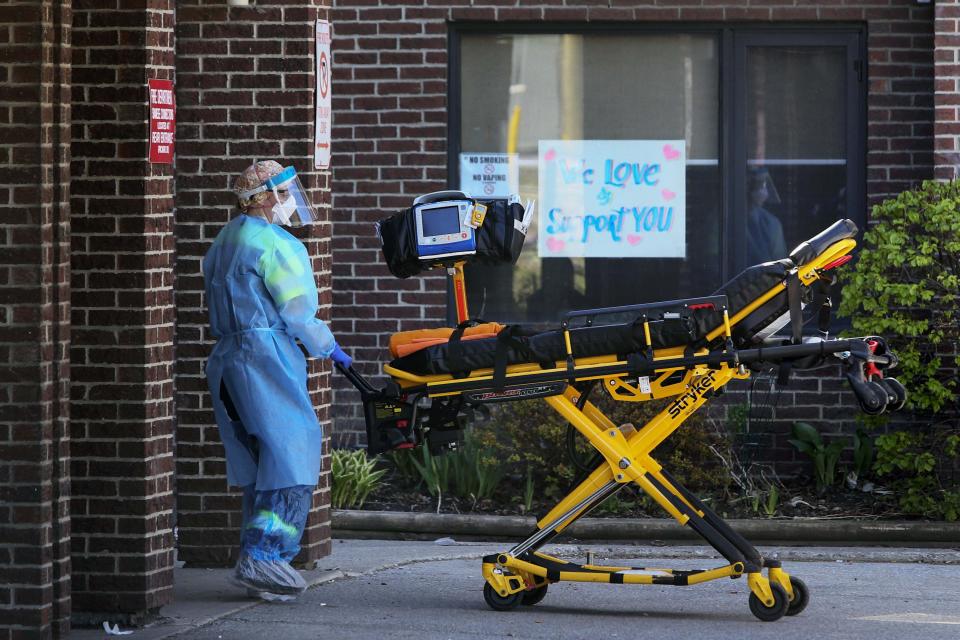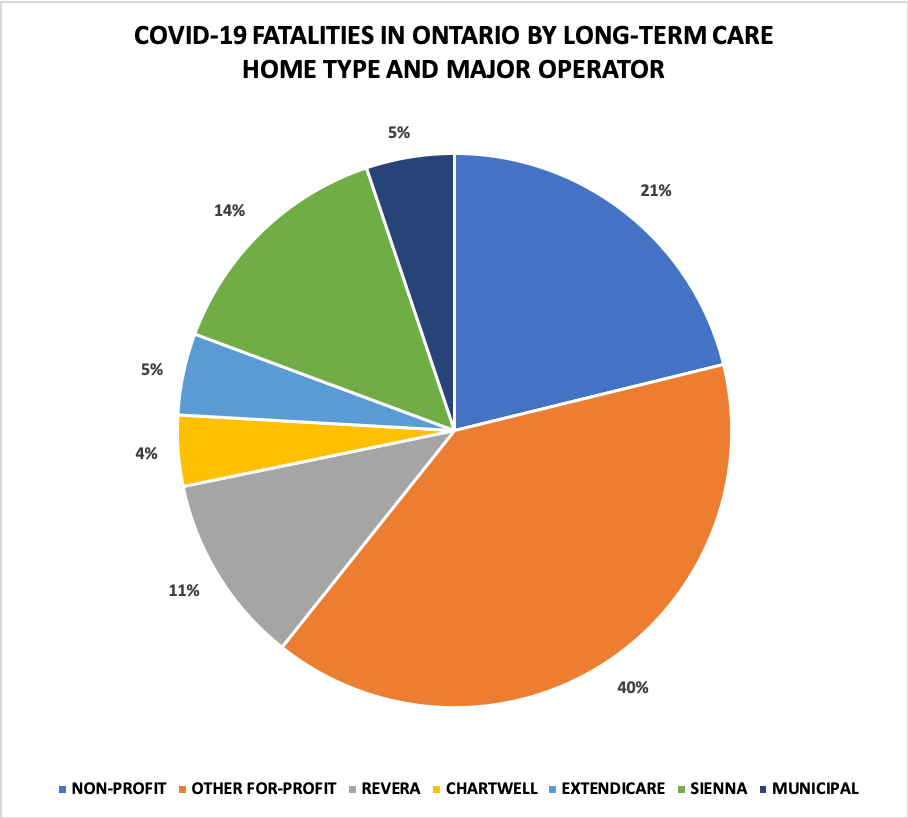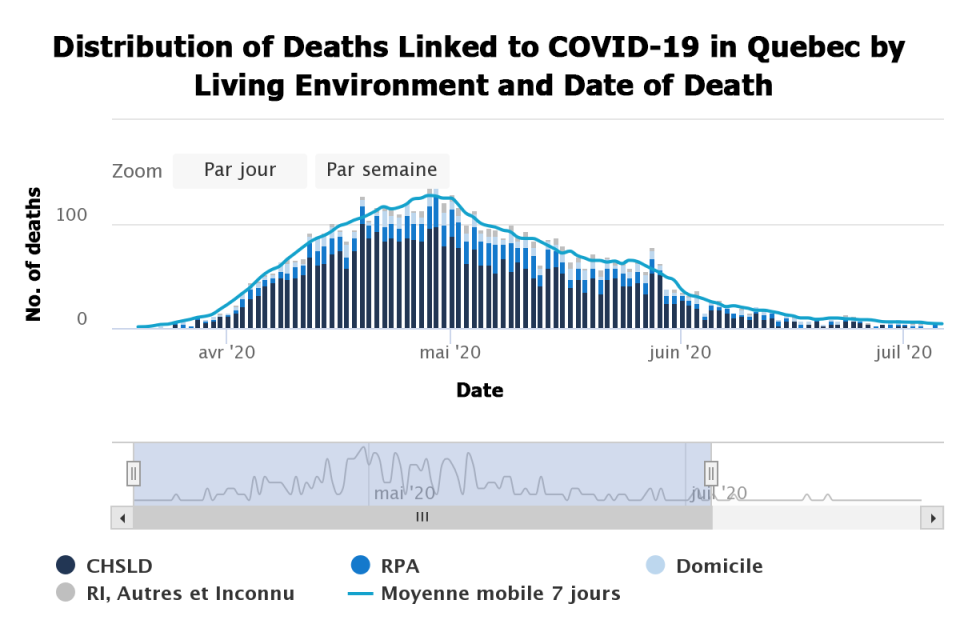"Profit over people": The business of Canada's for-profit long-term care sector called into question

Aaliyah* faced a lot of pressure and professional oversight working in an Extendicare long-term care home in the Toronto area over the past two years, but what she saw during the COVID-19 pandemic couldn’t compare. Amidst growing COVID-19 cases in April, she describes a lack of communication from management, inadequate training for frontline workers, some isolated patients missing meals, and slings being used across bedroom doors to prevent patients from wandering – there were even talks of sedating patients to control their movements.
One moment stood out to her as being particularly disturbing. “We were at our peak and didn’t want any more positive [COVID-19] results coming up, because once that positive comes up, you’re in outbreak for another two weeks,” Aaliyah told Yahoo Finance Canada. A doctor ordered a nurse to swab patients and send them to the lab. “But then the administrator found out and said, ‘don’t send them.’” Aaliyah warned the doctors that the administrative team was trying to stop the swabs from getting out. This eventually led to a back-and-forth argument between the doctor and administrative team until the doctor said “I’m ordering the swabs and I’m done”.
After the swabs were tested for COVID-19, Aaliyah says, one test came back positive.
The Long-Term Care Problem in Ontario
The COVID-19 pandemic called the state of for-profit long-term care homes in Canada into question. In Ontario, 57 per cent of nursing homes are for-profit, followed by private non-profits, which account for 26 per cent, and municipal homes which make up 16 per cent. As of late June, the private for-profit homes reported the highest mortality rate at nine per cent, versus non-profit homes (5.25 per cent) and publicly-operated municipal homes (3.62 per cent), according to the Ontario Health Coalition.

The higher mortality rate from patients who had tested positive for COVID-19 doesn’t surprise Amit Arya, a palliative care physician with a special interest in long-term care, holding joint faculty appointments in the Division of Palliative Care at McMaster University and the University of Toronto.
"It is about prioritizing profit over people. That's the whole principle when we're running any sector like a business,” he told Yahoo Finance Canada in an interview. “What will happen is that any extra money that's in the system will not be reinvested into the care of the people, and also the well-being and safety of the health workers."
Arya added that for-profit homes tend to lag non-profit and municipal homes in safety upgrades. Upgrading these homes, Arya says, would avoid crowding issues in senior homes where three or four residents can be assigned to a single room, increasing the likelihood of virus transmission.
From over-crowding to under-staffing and a lack of equipment, a report by the Canadian Armed Forces (CAF) regarding its intervention in care homes exposed many shortcomings. Among them was the Altamont Care Community owned by Sienna Senior Living, where families of residents launched a class action lawsuit against the company.

Canada’s major senior care and retirement operators, including Chartwell, Revera, Extendicare and Sienna, each suffered resident fatalities from the pandemic. Yahoo Finance Canada compiled the long-term care case data across for-profit homes under these operators, which run between 80 to over 200 homes** each across the country and have over 10,000 employees each, finding that the distribution of deaths has largely been balanced across the companies. They held a combined 34 per cent of all deaths reported in long-term care homes by late June while holding approximately 41 per cent of all Ontario residents in its homes. Other for-profit homes in the province took up 40 per cent of the COVID-19 deaths, held largely by residences like Orchard Villa (with 78 resident deaths as of June), Eatonville Care Centre (42 resident deaths) and Hawthorne Place (42 deaths) - all of which were named in the CAF report.
Public alarm over the deaths prompted companies like Sienna and Revera to write messages to stakeholders.
The Business of For-Profit LTC Operators
At the head of investment decisions, the boards across major operators in Ontario include few directors with backgrounds in medical or senior care. Major operators like Chartwell, Revera, and Sienna are led by boards heavily weighted with real estate, investment and business professionals. Directors and managers with a medical or senior care background make up a small portion. The for-profit operator Extendicare has a board with a larger proportion of directors who have experience in nursing and medicine, and have more members who formerly served on medical boards.
Arya says the lack of medical expertise on boards of long-term care homes is a problem. “On these boards – or the people in administration in these long-term care facilities – should not only have healthcare experience, but they should have healthcare experience in the needs of seniors and people with disabilities." Arya went further to add that these boards should have representation from actual residents or family caregivers with ground-level experience of what these homes need.
Arya says the focus on profit-making in real estate is setting up a problem for Canada’s senior healthcare sector. "A nursing home is not a real estate investment,” Arya said. “It shouldn't be."
For Aaliyah, walking the floors of Extendicare in the peak of the pandemic highlighted conflicting priorities. "I'm not surprised that the board of directors [don’t have] a health background. Like my administrator, for example, she doesn't,” said Aaliyah. “A lot of people say she saves a lot of money, but my question is, at whose expense,” she added. “I see that a lot in our home. The profit is always coming before the care and particularly when I have conversations with my administrator."
Despite the pandemic, Chartwell reported 1.2 per cent growth in total resident revenue of $2.6 million, and a net loss of $1.9 million (compared to $1.6 million in 2019) according to second quarter results released on August 6. Chartwell also reported a decline in quarterly EBITDA with $65.9 million in Q2 2020 compared to the $76.1 million in Q1 2020. Despite declining occupancy from May to July, the company’s dividend stayed the same as the previous quarter.
Chartwell has focused on developing new properties and property acquisitions to boost its top-line growth. The pandemic strained the company’s income, with a lower occupancy across its property portfolio while taking on the expenses of developing and acquiring other properties.
Extendicare also maintained its dividend and in its second quarter results reported an adjusted EBITDA of approximately $11 million, as well as a 4.7 per cent increase in revenue to $281.9 million over last year which was “driven by COVID-19 funding, LTC funding enhancements and growth in retirement living and other operations”. A spokesperson from Extendicare explained that ‘COVID-19 funding’ refers to support received from the provinces to address pandemic-related expenses, including pandemic pay for frontline and homecare workers, bringing on additional staff and increasing supply needs.
In this same release, the operator stated it received $21 million under the Canada Emergency Wage Subsidy (CEWS). The statement explained that the funding would be used to maintain staffing levels and the company anticipates seeking additional funding in the upcoming weeks.
Sienna suffered a drop in EBITDA in 2020 to $54.4 million, compared with $66.1 million in 2019. Last year, the company announced an increase in its quarterly payout by two per cent and has since maintained its dividend.
In a conference call discussing Q2 results, recently appointed CEO Vlad Volodarski explained the company’s post-pandemic goals. “As provincial economies begin to gradually re-open and numerous restrictions are being lifted, we are resuming our leasing activities, including virtual and traditional personalized tours for our prospective residents.”
British Columbia’s Government-Involved Solution
Long-term care homes in British Columbia reported fewer outbreaks and fatalities related to COVID-19 patients, including in for-profit homes, reaching 121 deaths in late June.
Dr. Jennifer Baumbusch, an associate professor at the University of British Columbia School of Nursing, says the government deserves the praise for the low virus impact. “I think it was definitely more on the government's part, and on SafeCare BC [that the spread was mitigated],” Baumbusch told Yahoo Finance Canada. “I think that without the government support, we would have seen this spread happen much more rapidly across our care homes.”
The B.C. government guaranteed increased salaries for frontline healthcare workers to prevent the need for them to work shifts at multiple homes which could widen the spread of the virus, and ensured there was an adequate supply of personal protective equipment. This support was available for all care homes, whether they were publicly-funded, non-profit or for-profit.
Non-profit homes spent $10,000 (or 24 per cent) more per resident per year than for-profit homes despite receiving the same amount of public funding, according to a report by the Office of the Seniors Advocate. As far as publicly funded hours that residents spend with hands-on direct care workers, the for-profit sector was short of the target by 207,000 funded hours, whereas non-profits exceeded the amount of direct care hours they were publicly funded to deliver by 80,000 hours.
“So, definitely that creates differences in quality and the amount of staff time with each resident and all of that is going to play out in terms of the risk that they're taking if something like a virus or a pandemic situation occurs,” Baumbusch explained.
Quebec
In Quebec, the COVID-19 outbreak reporting between non-profit and for-profit homes was less consistent than British Columbia and Ontario. Government health sites categorize these homes between residential and long-term care centers (CHSLD) and private seniors’ residences (RPA) homes. CHSLD homes house residents with a significant loss of autonomy who require more hands-on care. RPA homes allow residents to have more independence, but still have on-site staff. By late July, the Government of Quebec reported 5,714 deaths across all homes, the majority of which were reported in CHSLD homes at 69 per cent. RPA homes reported 17 per cent of deaths in long-term care homes across the province in comparison.

Company Responses
Chartwell shared a statement with Yahoo Finance Canada about the company’s response to the COVID-19 crisis, saying that while some homes in its portfolio have had outbreaks, the “majority remained COVID-19 free”. The statement addressed the company’s for-profit revenue model, saying “Revenue in LTC is 100% controlled by the government. No profit can be generated from government funding for resident care and services. What is not spent on care and services is returned to government.”
Arya says statements like these are misleading, explaining that public funding isn’t used for profit; it’s used for fixed operating expenses.
“It is important to note that not-for-profit and municipal homes will spend all envelope funding on resident care,” Arya explained. “Any left over money will be reinvested into the care of the residents, rather than siphoning it away. For-profit homes will minimize the cost of front-line care, and avoid other important needs such as building improvements, creating a reserve fund etc. to ensure that shareholders have the highest return on their investment.”
Regarding the quality of care in for-profit homes Chartwell said that 38 per cent of Ontario’s 626 long-term care homes have been built to 1970’s standards, which include many three to four-bedroom ward rooms where distancing has been a challenge. The company stated that 83 per cent of these older homes are privately owned by for-profit operators.
Extendicare told Yahoo Finance Canada’s that the difficulty of containing the virus came from the fact that many symptoms were not immediately visible, but says it is testing its staff members.
“We categorically disagree with the oversimplified assertion that a home’s ability to manage a COVID-19 outbreak comes down to ownership model. Rather, it’s a complex mix of a number of factors,” the statement said, citing older homes and the unknown traits of the COVID-19 virus.
Arya argues that the funding is there to redevelop these homes, though for-profit industry “has been taking away billions of dollars of money to pay their shareholders.” Arya added few non-profit homes had homes with old design standards. “These homes have found the money to re-develop beds without the money that for-profit homes are asking for.”
Cost efficiency gave way to maximizing profit, according to Arya, giving for-profit homes less capital to work with once a crisis like a pandemic hits.
The Ontario Long Term Care Association (OLTCA) told Yahoo Finance Canada that a “number of longstanding and systemic issues left long-term care homes facing a ‘perfect storm’ of conditions”, which the organization outlined in a report released this year. The concerns included cohorting residents, lack of staffing, and a lack of funding.
The OLTCA is a provincially-registered group that represents 70 per cent of Ontario’s long-term care homes of all ownership types, including for-profit, non-profit and municipal. A spokesperson explained that its funding comes from membership dues. The board of directors includes long-term care industry leaders, including executives from Sienna, Revera, Chartwell and Extendicare.
When asked about the lack of medical representation on the boards of long-term care homes, Sienna pointed to its recent appointment of Joseph Mapa, the former Sinai Health System chief executive officer, amongst other medical professionals and advisors who will help guide the company’s policies during the pandemic.
For Aaliyah the connection between medical expertise and quality care is clear when you have a frontline seat in a pandemic. "Leadership, management, the director of care, were not walking the floors, because they themselves were afraid. They didn’t see what was happening,” she said. “By the time we got in specialized support and other infection control specialists, we were at our peak. If we would have been prepared beforehand with that kind of expertise, a lot of the stuff could have been prevented."
*Yahoo Finance Canada has agreed to use a pseudonym for the Extendicare worker who spoke to us, as she was not authorized to describe operations within the home where she is employed.

 Yahoo Finance
Yahoo Finance 